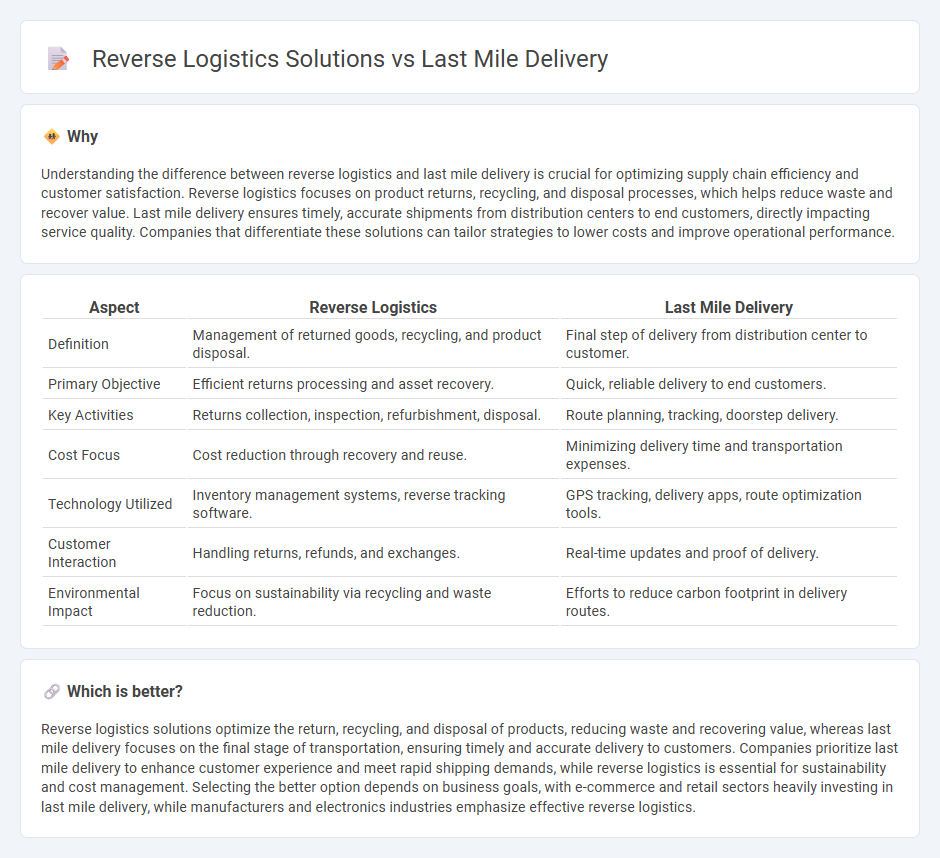
Reverse logistics solutions focus on managing product returns, refurbishments, and recycling processes to optimize operational efficiency and sustainability. Last mile delivery emphasizes the final step of transporting goods from distribution centers directly to customers, ensuring timely and accurate order fulfillment. Explore the key differences to enhance your supply chain strategy.
Why it is important
Understanding the difference between reverse logistics and last mile delivery is crucial for optimizing supply chain efficiency and customer satisfaction. Reverse logistics focuses on product returns, recycling, and disposal processes, which helps reduce waste and recover value. Last mile delivery ensures timely, accurate shipments from distribution centers to end customers, directly impacting service quality. Companies that differentiate these solutions can tailor strategies to lower costs and improve operational performance.
Comparison Table
| Aspect | Reverse Logistics | Last Mile Delivery |
|---|---|---|
| Definition | Management of returned goods, recycling, and product disposal. | Final step of delivery from distribution center to customer. |
| Primary Objective | Efficient returns processing and asset recovery. | Quick, reliable delivery to end customers. |
| Key Activities | Returns collection, inspection, refurbishment, disposal. | Route planning, tracking, doorstep delivery. |
| Cost Focus | Cost reduction through recovery and reuse. | Minimizing delivery time and transportation expenses. |
| Technology Utilized | Inventory management systems, reverse tracking software. | GPS tracking, delivery apps, route optimization tools. |
| Customer Interaction | Handling returns, refunds, and exchanges. | Real-time updates and proof of delivery. |
| Environmental Impact | Focus on sustainability via recycling and waste reduction. | Efforts to reduce carbon footprint in delivery routes. |
Which is better?
Reverse logistics solutions optimize the return, recycling, and disposal of products, reducing waste and recovering value, whereas last mile delivery focuses on the final stage of transportation, ensuring timely and accurate delivery to customers. Companies prioritize last mile delivery to enhance customer experience and meet rapid shipping demands, while reverse logistics is essential for sustainability and cost management. Selecting the better option depends on business goals, with e-commerce and retail sectors heavily investing in last mile delivery, while manufacturers and electronics industries emphasize effective reverse logistics.
Connection
Reverse logistics solutions streamline the process of returning products from consumers to retailers or manufacturers, ensuring efficient handling of returns, repairs, or recycling. Last mile delivery focuses on the final step of delivering goods to the end customer, impacting customer satisfaction and operational costs. Integrating reverse logistics with last mile delivery optimizes transportation routes, reduces delivery times, and enhances sustainability by consolidating outbound shipments and returns within the same logistical framework.
Key Terms
**Last Mile Delivery:**
Last mile delivery focuses on the final step of the shipping process, ensuring packages reach the customer's doorstep efficiently and on time, leveraging technologies like GPS tracking and route optimization to enhance operational speed. It plays a critical role in customer satisfaction for e-commerce businesses by minimizing delays and offering flexible delivery options such as same-day or scheduled deliveries. Explore how advanced last mile delivery solutions can transform your supply chain performance and improve customer experiences.
Route Optimization
Last mile delivery emphasizes efficient route optimization to ensure timely package arrivals, reduce fuel consumption, and lower operational costs through dynamic routing algorithms and real-time traffic data analysis. Reverse logistics solutions leverage route optimization to streamline the collection of returned goods, maximize vehicle utilization, and minimize environmental impact by reducing unnecessary trips. Explore how advanced route optimization technologies enhance both last mile delivery and reverse logistics for improved supply chain performance.
Proof of Delivery (POD)
Proof of Delivery (POD) is essential for both last mile delivery and reverse logistics solutions, providing verified confirmation that shipments have reached their intended destination or have been successfully returned. In last mile delivery, POD enhances customer trust and operational transparency by capturing signatures, timestamps, and geolocation data upon delivery. Explore how advanced POD technologies improve efficiency and accuracy in your supply chain management.
Source and External Links
Last mile delivery: solutions for your business | DHL Discover - Last mile delivery is the final leg of a package's journey from a local distribution center to the end consumer, focusing on delivering packages as affordably, quickly, and accurately as possible via road or drop-off points, with growing importance on rapid, reliable, and traceable delivery options including next day and eco-friendly services.
What is Last-Mile Delivery? Logistics, Costs, and Top Carriers - Last-mile delivery is the transportation of a package from a fulfillment center to its final destination, usually a residence, where carriers focus on speed, cost-efficiency, and tracking, though it remains one of the most expensive logistics stages costing about $10.10 per order on average.
Last Mile Delivery Logistics, Trends and Data for Retailers Explained - Last-mile delivery is the final phase where the product moves from a warehouse or distribution center directly to the customer's doorstep, being critical for customer satisfaction because it is costly and time-consuming but drives faster delivery, increased sales, and operational efficiencies through technologies and innovative supply chain models.
 dowidth.com
dowidth.com